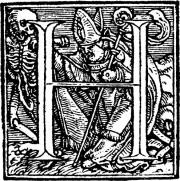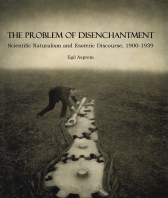There has been some debate about aspects of my book the last couple of days, following Dan Harms’ review, and my own response. Sarah Veale joined in with a post over at Invocatio, and today Dan responded once more on his blog. The debate has revolved around the Enoch figure, and the role of this figure in understanding Dee’s angel conversations. I argued that too much importance has typically been attributed to the patriarch in accounts of the angel diaries, and that the term “Enochian magic” may itself be somewhat misleading in this regard. I still stand by this claim, but I must also guard against a misunderstanding that seems to creep up.
As noted earlier, the pseudepigraphical Book of Enoch was only rediscovered in the West at the end of the 18th century, and hence a major source of information on Enoch was unavailable to Dee. By this I do not, however, wish to suggest that Dee had no knowledge about the patriarch. That would obviously be untrue: Dee clearly had a great deal of knowledge about the many more or less esoteric interpretations of this figure, from the early church fathers to renaissance esoteric discourses. This is evident from the mentions of Enoch that we do find in Dee’s (and Kelley’s) work.
I even find Dan’s point that precisely the lack of access to a much rumoured, lost Book of Enoch may have been an incentive to recover it (or parts of it) to be an interesting one:
What sets Enoch apart from the other Biblical figures in touch with angels, such as Daniel and Tobit, was the existence of a text mentioned by the church fathers dealing with angels but now lost. As such, the interest was intense in discovering it – in fact, intense enough to create volumes attributed to Enoch, in the same manner as the Necronomicon was created in the twentieth century.
The parallel with the fictional Necronomicon giving rise to various real books claiming to be the real deal is instructive. Again, the history of Western esotericism is replete with examples of someone’s fiction becoming someone else’s reality.
However, my point remains this: when we look at the angel conversations as a whole, Enoch is only one among many references, and as a project it certainly does not revolve around this one figure. Renaissance natural philosophy is, again, the most important context for the creation of the angel diaries as such. To take one example: just as many other natural philosophers of the era, Dee was interested in learning the language of Adam – Enoch is merely the example of another post-lapsarian human being who according to legend acquire this language from the angels, thus presumably showing that the endeavour is possible in principle.
The debate started from Dan’s observation that one could not find much information on the Enoch mythology in my book. I’ll admit this much: With hindsight, I regret not having added a discussion on the development of the “Enochian” label. Where does it arise, how does it spread, and when does it become eponymous for the whole magical system and even the angel diaries on the whole? That would potentially have been a very illuminating discussion, and it might have cleared up some misunderstandings.
A full answer requires more careful source study, but it is clear enough that this is a phenomenon belonging to the reception of Dee’s work. One could say that it is the convergence of “Enoch reception” and “Dee reception”. It seems to start already in the first century after Dee’s death (1600s), when some of the material is presented in manuscripts with titles referring to Enoch. Dan mentions how Liber Sixtus et Sanctus was entitled The Book of Enoch in transcription (probably by Elias Ashmole); one could add to this the so-called “Rudd material”, consisting of magical squares and letters copied from the Casaubon edition of Dee’s diaries, and presented as “The Tables of Enoch”. The tables referred to appear under a different name in the original, and the “Enochian” interpretation is wholly an invention of the author of the grimoire (whoever he was – I discuss this in Arguing with Angels, pp. 32-38). Much later on, of course, “Enochian” becomes the generic term for all the magic borrowed from the Dee material, when the Golden Dawn starts using it in their teachings and initiation ceremonies – without even mentioning Dee and Kelley as originators (see ibid., pp. 53-54).
This is an admittedly scanty and impressionistic genealogy, and I can only hope that someone will look deeper into this issue in the future. Perhaps I’ll even do it myself one day?
![]()
This blog post by Egil Asprem was first published on Heterodoxology. It is licensed under a Creative Commons Attribution-ShareAlike 3.0 Unported License.






[…] Egil Asprem has responded to Harms’ post and suggests that while the material was not unknown to Dee, it was one of […]
[…] Egil answers my post, and I think we’re now fundamentally on the same […]
Thanks for this. You may find the following of interest: http://paleojudaica.blogspot.co.uk/2012_07_15_archive.html#8561819568872081719
This is excellent, thank you!
[…] ‘On Enoch reception and Dee reception‘. Heterodoxology (Clarifying my point about how Enoch has been made to be more important for […]